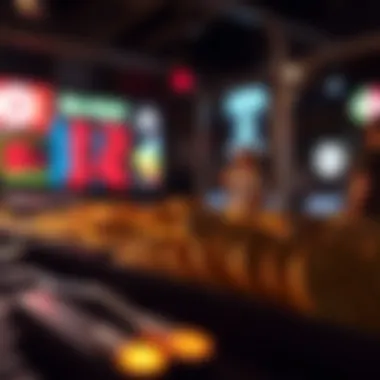Exploring Recent NFT Sales Trends and Market Impact


Intro
In recent years, non-fungible tokens (NFTs) have transformed the digital landscape more than most can fathom. What began as a niche corner of the cryptocurrency world has surged into a billion-dollar market with ramifications for artists, collectors, and investors alike. This evolution is drawing interest from a wider audience, intrigued by the blend of technology, art, and finance.
To properly navigate this space, it’s crucial to understand the basics behind cryptocurrency and the technology that powers it. Without this grounding, grasping the nuances of the NFT market can feel overwhelming.
As we embark on this examination, we will break down the essential components of cryptocurrency and the factors driving current trends. This will equip readers not just with information, but with insight that heralds both the present and the likely future of NFTs.
Cryptocurrency Fundamentals
Understanding Blockchain Technology
At the core of every cryptocurrency lies blockchain technology, a decentralized ledger that records all transactions across a network of computers. Unlike traditional banks, which centralize records, blockchains offer more security and transparency. This is crucial for NFTs, as they rely on blockchain to prove authenticity and ownership.
Think of blockchain as a public bookshelf. Everyone can see what books are on it, who has borrowed them, but no one can alter the records without consensus. This makes blockchains a reliable source of truth.
Key Concepts in Cryptocurrency Trading
Diving into cryptocurrency trading, it’s vital to grasp some foundational concepts. Here are a few key points:
- Volatility: Unlike typical fiat currencies, cryptocurrencies can experience wild price swings. This volatility can be both an opportunity and a risk.
- Liquidity: Refers to how easily assets can be bought or sold in the market without affecting their price. In NFT trades, liquidity can often be lower than in traditional markets.
- Market Capitalization: This is the total market value of a cryptocurrency, calculated by multiplying the current price by its circulating supply. A higher market cap may indicate a more established asset.
- Decentralized Finance (DeFi): A movement that uses blockchain-based technology to recreate traditional financial systems without intermediaries. DeFi can encompass NFT sales as well.
Understanding these concepts forms the backbone of engaging with NFTs as investment vehicles. Knowing how they fit within the broader ecosystem aids individuals in making informed decisions.
Market Insights
Current Trends in the Crypto Market
Today, NFT sales have entered the mainstream. High-profile auctions and celebrity endorsements have steered a spotlight onto the market. For instance, digital artist Beeple’s work sold for a staggering $69 million at Christie’s auction house. Such jaw-dropping figures highlight not just the hunger for digital assets, but also the shifting perceptions about value in the digital age.
According to recent statistics:
- The NFT market saw over $25 billion in sales in 2021, more than 600% growth year-on-year.
- Art-based NFTs are leading the charge, but sectors like gaming and virtual real estate are gaining traction rapidly.
Analyzing Market Movements and Predictions
Market trends can often appear like trying to read tea leaves; they shift and change unpredictably. However, some analysts utilize tools like technical analysis and market sentiment to navigate these waters.
“In the volatile world of NFTs, understanding market behavior is key to capitalizing on trends.”
Looking ahead, several factors may influence future NFT sales:
- Regulatory Developments: Laws governing cryptocurrencies can impact how NFTs are bought and sold.
- Emerging Platforms: As more platforms facilitate NFT transactions, competition may drive innovation and lower fees.
- Cultural Integration: As more artists and brands enter the world of NFTs, mainstream acceptance may bolster demand.
These insights paint a clearer picture of the current blockchain landscape and help to understand the rich tapestry of NFTs. Equipped with this knowledge, individuals can approach investments with more than just hopeful speculation. It's about being informed.
Understanding NFTs
Understanding NFTs is crucial for anyone looking to navigate the intricate landscape of digital assets today. Non-fungible tokens, or NFTs, represent a seismic shift in how we perceive ownership, especially in the realms of art, collectibles, and even real estate. As our world increasingly embraces digital innovation, grasping the fundamental characteristics of NFTs can equip investors and enthusiasts with the knowledge needed to make informed decisions.
The significance of NFTs extends beyond mere ownership; they introduce concepts of scarcity, provenance, and authenticity in a digital context. Each NFT is unique, several properties that can’t be replicated. This uniqueness allows NFT creators, whether artists or musicians, to monetize their work in ways previously unexplored. However, with opportunities come complexities and challenges. Investors must be aware of factors like market volatility, copyright issues, and potential scams that can arise in this still-evolving ecosystem.
When looking to engage in this market, it’s essential to start with a solid understanding of what NFTs are, how they function, and why they matter. The insights gained from this section will serve as the bedrock for the entire article.
Definition and Characteristics
To truly appreciate NFTs, one must first grasp their definition and the unique characteristics that set them apart from other digital assets. NFTs are cryptographic tokens that exist on a blockchain, which ensures the ownership and transferability of these tokens. Unlike cryptocurrencies such as Bitcoin or Ethereum, where each unit is interchangeable and identical, every NFT has distinct attributes and information that make it one-of-a-kind. This peculiarity allows for the creation of digital items that can represent anything from artwork and music to virtual real estate.
Key characteristics of NFTs include:
- Indivisibility: Unlike Bitcoin, which can be divided into smaller units, NFTs cannot be split. You either own the full token or none at all.
- Ownership: The blockchain records the owner of an NFT, providing a transparent and unchangeable ledger of who owns what.
- Smart Contracts: NFTs can include smart contracts, enabling automated transactions and conditions for resale, which can benefit artists and creators.
- Scarcity: The ability to control the quantity of tokens ensures that creators can generate limited editions of their work, adding to their value.
These attributes underline why NFTs have grown rapidly in popularity in various industries. The digital art revolution is a prime example, allowing artists to reach a global audience and avoid traditional gatekeepers.
Comparison with Traditional Assets
How do NFTs stack up against traditional assets? This is a hot topic of discussion as more individuals and institutions transition toward digital collectibles and investments. On one hand, NFTs share some characteristics with traditional assets like art and real estate but differ in significant ways.
Consider the following comparisons:
- Liquidity: Traditional assets can take time to sell, often requiring intermediaries such as dealers or brokers. In contrast, NFTs boast a potentially vast audience online, making it easier to sell quickly on platforms where buyers are ready to engage. However, this comes with significant volatility, which traditional assets often do not face.
- Valuation: The value of traditional assets usually relies on market trends and expert appraisals. In the NFT space, value can fluctuate dramatically based on trends, creator reputation, and social media hype. An item that may cost thousands one day might plummet in value overnight.
- Physical Evidence vs. Digital Verification: Traditional assets often require physical inspection for verification, while NFTs rely on blockchain technology as proof of authenticity. This aspect eliminates the need for a third party to assess or validate items, streamlining transactions.
Understanding these comparisons offers investors a broader perspective on the risks and rewards associated with NFTs versus traditional investing. As the NFT market continues to evolve, recognizing such distinctions will become increasingly important for those looking to make informed investment decisions.


Current Market Landscape
Understanding the current market landscape of non-fungible tokens (NFTs) is crucial for anyone stepping into this dynamic space. It offers a glimpse into how the market is evolving, and sheds light on the behaviors and patterns that govern buying and selling in this unique segment of digital assets. Investors and traders can greatly benefit from understanding sales trends and the marketplaces that dominate the scene.
Sales Volume Trends
Sales volume trends in the NFT market are like the heartbeat of a living organism; they tell us how healthy or turbulent the ecosystem is. Over the past year, there have been considerable fluctuations in sales volumes, especially following major announcements or events within the crypto sphere. For instance, periods of high speculation often coincide with sharp spikes in sales, while calmer periods can witness a substantial drop in trading activity.
In 2023, a notable trend has been the resurgence of interest among collectors and investors, which has led to record sales volumes in specific segments. The winter of 2022 saw a cooling off, but recent data indicate that certain categories of NFTs, particularly digital art and gaming assets, have begun to attract attention once more.
"The ebb and flow of NFT sales reflect investor sentiment akin to waves on a shore, with peaks of excitement giving way to quieter moments.”
To illustrate:
- High-Value Transactions: Major artworks and collectibles have fetched staggering sums recently, boosting overall sales volume.
- Frequent Sales Events: Weekly auctions on platforms like OpenSea or Rarible have become commonplace, attracting casual buyers and serious investors alike.
- Diversity in Offerings: The emergence of new creators and projects adds layers of complexity to sales trends, often making it challenging to predict what will be in demand next.
Most Active Marketplaces
When it comes to buying and selling NFTs, the platforms themselves play a key role in shaping market dynamics. The most active marketplaces serve as the bustling bazaars of the digital asset world, where every transaction tells a story.
Currently, OpenSea stands out as the titan among NFT marketplaces, handling a significant share of sales volume. It's where many collectors first dip their toes into the waters of NFT trading due to its user-friendly interface and vast selection of items. Moreover, the rise of platforms like LooksRare and Blur has introduced newfound competition, encouraging innovation and better services for users.
Some factors to consider regarding these marketplaces include:
- User Experience: Intuitive designs often attract more buyers and sellers.
- Gas Fees: Platforms with lower transaction costs can sway users toward more favorable trading conditions.
- Community Engagement: Active communities within these platforms can help boost visibility and desirability for particular projects.
In essence, understanding these platforms can inform investment strategies. Knowing where the action is happening helps traders position themselves favorably for future transactions.
Notable Recent NFT Sales
In the ever-evolving landscape of digital assets, the recent surge in notable NFT sales stands out as both pronounced and indicative of larger trends within the cryptocurrency world. Understanding these sales helps investors and enthusiasts alike grasp the shifting dynamics of value in the digital realm. High-profile transactions not only capture attention but also illustrate the market's potential and the cultural significance of NFTs today.
Key elements and benefits of exploring notable sales include:
- Market Indicators: Significant sales often reflect wider investment trends, signaling confidence (or lack thereof) in the NFT market.
- Cultural Catalysts: Many sales involve artists or collections that have transcended mere financial transactions, becoming cultural phenomena that shape public perception.
- Opportunity Identification: Analyzing what made certain NFTs desirable illuminates patterns that can influence future investments and collection strategies.
As the NFT ecosystem continues to mature, these sales act as bellwethers, guiding stakeholders through the intricate web of choices they face.
Record-breaking Transactions
NFTs that command staggering prices often redefine expectations around digital ownership. Take, for instance, the sale of Beeple's "Everydays: The First 5000 Days", which sold for a jaw-dropping $69.3 million at a Christie's auction. This infamous transaction not only marked a watershed moment for NFTs but also positioned Beeple as one of the most celebrated digital artists in the world.
Another iconic transaction is the sale of CryptoPunk #7804 for $7.6 million. These pixelated characters have become a digital status symbol, emblematic of the intersection between art and technology. The prices fetched by these NFTs create ripples across investor communities, sparking dialogues about the valuation of digital assets.
Emerging Artists and Their Works
While established creators continue to make headlines, the NFT market is also rich with emerging talents showcasing their unique works. Artists like Pak and XCOPY have carved out notable niches with their innovative approaches and distinctive aesthetics. Pak, for instance, gained immense recognition with projects like "The Merge," which introduced a new format of art ownership where collectors participated in the piece’s growth, ultimately fueling buzz and engagement within their communities.
These newer artists are not merely following trends; they are pushing boundaries. Their creative outputs often involve commentary on the digital age, urging collectors to perceive their NFTs as more than just static images but experiences worth engaging with.
Collections That Made Waves
In addition to individual works, certain collections have significantly influenced the market. The Bored Ape Yacht Club (BAYC) stands out for its community-driven approach, providing not just a digital asset but also membership to an exclusive club. With unique art and clever marketing, it has redefined how collectors view ownership in the NFT realm.
Collections like Doodles and World of Women have also created substantial community engagement and social impact. They've fostered connections and conversations, ensuring their relevance transcends just the financial stakes attached.
"These collections shift the narrative from individual ownership to community belonging, redefining the value generated through collaboration and shared experiences."
As NFTs continue to change the way we perceive art and ownership, notable recent sales, the impact of emerging artists, and groundbreaking collections signal a promising future. Being attuned to these elements signals not just awareness but also strategic advantage in navigating the complex world of NFTs.
Factors Driving Recent Sales
The NFT market isn’t just a bubble ready to burst—it's a dynamic ecosystem shaped by multiple driving forces that fuel its recent upsurge. Understanding these factors is critical for anyone looking to navigate or invest in this domain. The reasons behind the recent explosion of NFT sales encompass market speculation, cultural influences, and breakthroughs in technology that transform the way we view ownership and authenticity.
Market Speculation and Investor Sentiment
One cannot ignore the thick cloud of speculation that hangs over the NFT landscape. Many investors dive into the market with dreams of striking gold at an opportune moment; they hope to cash in on the soaring prices of digital assets.
- Volatility: The soaring prices of certain NFTs have drawn a lot of attention, leading to a kind of FOMO (fear of missing out) among investors. When a piece of digital art sells for millions, it's only natural for others to want a piece of the action.
- Market Analysis: Speculation often leads people to buy based on trends rather than inherent value. The thrill of riding a wave can sometimes overshadow informed decision-making.
However, there's more to the equation than simple speculation. Investor sentiment shapes the market's direction in a way that can lead to trends both up and down. A sudden shift in public opinion or sentiment can trigger immediate changes in sales volume, illuminating the fragile foundations of this market.
Cultural Influences and Celebrity Endorsements


The intersection of cultural dynamics and celebrity endorsements cannot be overlooked as major contributors to the NFT market's vibrancy. The blend of mainstream culture with the digital art world has birthed a new landscape where renowned personalities shape perceptions and demand.
- Cultural Relevance: When celebrities like Paris Hilton or Justin Bieber promote or release their own NFTs, they can capture vast audiences, introducing fresh crowds to the space. This expands the market beyond those previously engaged with crypto or digital art.
- Artistic Validation: Celebrities' involvement often lends a sense of legitimacy or desirability to certain collections. For instance, when musicians launch their album NFTs, it creates a buzz that sends fans racing to claim their piece of the action.
Yet, there's a cautionary tale as well. While celebrity influence can spark initial interest, it can also result in volatility. The market sometimes sees prices spike, only for them to fall when the novelty wears off. Therefore, while cultural trends can usher in new waves of interest, one must remain wary of their fluctuating nature.
Technological Advancements in Blockchain
The backbone of the NFT market is undoubtedly the technological advancements in blockchain. These innovations have substantially decreased the barriers to entry for both creators and collectors alike.
- Smart Contracts: These self-executing contracts written into the blockchain automate a variety of tasks around NFT transactions, ensuring security and transparency. This encourages creators to feel secure in minting their work, knowing that their rights are protected.
- Improved Infrastructure: Innovations in blockchain technology have made it easier and more cost-effective to create and trade NFTs. As transaction fees decrease and networks improve, the accessibility of NFTs increases, nurturing growth in sales.
As the technology continues to evolve, so does the potential for new use cases and applications. This evolution drives interest and sparks creativity, promoting more sales as both individual collectors and institutions recognize NFTs as valid digital assets worth their investment.
In summary, the factors propelling recent NFT sales tell a multifaceted story marked by speculation, culture, and technology. The interplay between these elements provides a fertile ground for growth, but they also highlight the volatility of this rapidly changing field.
"Understanding why NFTs sell it's not just numbers; it’s a reflection of culture and technology made manifest."
Useful Resources:
Case Studies of Successful NFTs
Understanding the case studies of successful NFTs is crucial for grasping the potential impact and direction of this burgeoning market. They offer concrete examples of how certain collections and individual NFTs have transcended typical trading figures, becoming cultural benchmarks in their own right. Through these case studies, we uncover the narratives behind these successful assets, the communities that have formed around them, and the broader implications for investors and artists alike.
CryptoPunks and Their Impact
CryptoPunks pioneered the NFT space and are often hailed as one of the very first collections to introduce the concept of digital ownership on the blockchain. Created by Larva Labs in 2017, these 10,000 unique 24x24 pixel art character collectibles have become synonymous with the NFT trend. Holding a CryptoPunk is like owning a piece of history in the digital art world.
The sheer numbers speak volumes; recent sales have seen individual CryptoPunks fetching astronomical prices, often reaching millions of dollars. This has sparked a wave of interest not only from collectors but also from tech-savvy investors who recognize the potential for ROI.
"The CryptoPunks have transformed from mere digital art into status symbols, encapsulating a sense of belonging to a pioneering community."
Moreover, CryptoPunks have laid the groundwork for other NFT projects, providing a blueprint for what can be achieved within this new medium. They highlight the intersection of technology, creativity, and finance, showing how art can adapt to and thrive within a digital economy.
Bored Ape Yacht Club: A Cultural Phenomenon
The Bored Ape Yacht Club (BAYC) burst onto the scene in early 2021 and quickly established itself as not just an NFT collection, but a cultural sensation. With its whimsical art style and a sense of community that resonates with buyers, BAYC transformed the concept of NFT ownership into something akin to a membership club. Owning a Bored Ape opens doors to exclusive events and parties, enhancing the appeal beyond just the artwork itself.
As celebrities joined the club, the demand skyrocketed. Each ape functions as a digital avatar, showcasing traits that appeal to influencers and the general public alike. This collection illustrates how NFTs can bridge the gap between art and lifestyle, leading to a new breed of networking opportunities.
By creating a robust community around the NFTs, BAYC has not only driven sales but also built a loyal fanbase. The power of community should not be underestimated—buying into BAYC is as much about the social narrative as it is about the investment potential.
Art Blocks: The Intersection of Art and Code
Art Blocks stands out as a fascinating case where generative art melds beautifully with blockchain technology. This platform allows artists to create algorithms that produce unique artworks on demand. Each piece is one-of-a-kind, generated at the moment of minting, which means collectors are not merely acquiring a fixed artwork but partaking in an evolving art experience.
Collectors value the unpredictability and creativity inherent in Art Blocks. The project has gained traction among collectors looking for a blend of aesthetics and innovation, demonstrating how technology can foster new artistic expressions.
In addition, the success of Art Blocks has prompted discussions about the role of the artist in a digital space, redefining how we think about authenticity in art. Each work's provenance is recorded on the blockchain, preserving the artist's credit while catering to collectors who seek both beauty and originality.
By blending art and computation, Art Blocks exemplifies how NFTs can redefine artistic practices, creating a new paradigm in the art world where the code itself is a vital part of the creative process.
Regulatory Considerations
As the NFT market continues to gain traction, the importance of understanding regulatory considerations cannot be overstated. These regulations not only affect how NFTs are bought and sold but also influence the sustainability and perceived legitimacy of the entire market. With increasing interest from both investors and mainstream consumers, regulatory frameworks are crucial for paving a safe and transparent path forward. Without these guidelines, the market could end up resembling the wild west, filled with uncertainty and potential pitfalls.
Current Regulatory Landscape
Right now, the regulatory landscape surrounding NFTs is a patchwork of existing laws and emerging guidelines. In many jurisdictions, NFTs straddle a gray area, falling somewhere between collectibles, art, and financial assets. Some regulators are keen to classify them as securities, particularly when they are marketed with an expectation of profit. For example, in the United States, the Securities and Exchange Commission (SEC) has hinted at its authority to regulate certain aspects of the NFT space, requiring platforms and creators to disclose information that investors would need in order to make informed decisions.
Additionally, various countries are taking different approaches. The European Union is moving towards a more standardized regulatory framework, which aims to harmonize laws across member states. This could simplify compliance for NFT creators and traders, making it easier to navigate the complexities of international sales and ownership rights. Meanwhile, in places like China, there are strict limitations, leading to a volatile environment for NFT artists and collectors. Businesses need to be aware of local laws and adapt accordingly.
- U.S. Regulations: SEC involvement, definitions of securities
- European Union: Standardized regulations on digital assets
- International Variability: Regulations can differ vastly by country
Potential Future Regulations
Looking ahead, future regulations could introduce stricter compliance requirements in the NFT sector. There are a few areas that seem ripe for regulatory attention. For one, taxation of NFT transactions is likely to sharpen. Governments are increasingly looking to capitalize on the booming digital goods market, meaning that creators and sellers may need to report their earnings much like traditional income.
Another area to keep an eye on is consumer protection. As NFTs become more integrated into daily life, measures could be introduced to guard against fraud and misrepresentation. New regulations could demand transparency in how NFT platforms operate and mandate more thorough disclosures about the ownership rights of the digital assets.
The rise of decentralized finance (DeFi) and its overlap with NFTs also invites potential regulation. If platforms begin incorporating NFT collateralization for loans and other financial behaviors, authorities may impose rules to safeguard investors.


"The path of regulation is often a double-edged sword: it can protect consumers but also stifle innovation if not approached carefully."
- Taxation Standards: Possible future guidelines on NFT income
- Consumer Protection Laws: Enhancing transparency and rights
- DeFi Interaction: Monitoring NFT uses in financial activities
Navigating these regulatory waters will demand diligence and adaptability from all stakeholders in the NFT ecosystem. The eventual outcome remains uncertain, but one thing is clear: with proper oversight in place, the NFT market has the potential to grow not just in value, but in institutional trust as well.
For further reading, check resources like SEC's official site, European Commission's proposals, and the Financial Action Task Force for comprehensive updates on regulations.
Outlook for the NFT Market
The NFT market has taken the world by storm, capturing the interest of investors, tech enthusiasts, and artists alike. When it comes to predicting the future of this ever-evolving digital landscape, understanding the outlook for the NFT market is paramount. This section evaluates projected trends, the role of decentralization, and the overall potential impact these factors may have on future investments in non-fungible tokens.
Anticipating market movements not only aids investors in making informed choices but also allows them to navigate the trends shaping the industry. Here, we break down critical elements that will define the landscape of NFTs in the coming years.
Predicted Trends for the Coming Years
Predicated trends for the NFT market point toward several noteworthy shifts. Firstly, the demand for artwork and collectibles continues to grow, particularly for those linked to well-known brands or creators. The emergence of more innovative platforms, coupled with evolving consumer behavior, signifies that NFTs may soon be integrated into everyday transactions.
- Enhancements in User Experience: As marketplaces evolve, a streamlined user experience becomes vital. Simplified minting processes and intuitive navigation across platforms will invite a broader audience into the fold of NFT ownership.
- Integration of Real-World Assets: NFTs, once solely digital artifacts, are increasingly being tied to real-world assets such as property or luxury items. This could redefine asset ownership and further legitimize the space.
- Sustainability Initiatives: Given growing environmental concerns, there’s a push for greener practices within the blockchain community. Projects focusing on energy-efficient solutions will likely gain traction, attracting environmentally-conscious investors.
Consider how these trends may influence the landscape:
- Wider Usage Across Industries: Industries beyond art, including gaming and music, are increasingly adopting NFT technology to represent ownership, rights, and access.
- Legal Frameworks: As regulations become clearer, buyers and sellers will have a firmer understanding of their rights and responsibilities, fostering trust in the market.
- Increased Institutional Investment: Established financial institutions might begin allocating funds into NFT projects, further legitimizing and stabilizing the space.
"The integration of NFTs with the broader financial ecosystem will drive growth."
Role of Decentralization
Decentralization will surely play a critical role in shaping the future of the NFT marketplace. Removing intermediaries enables a direct connection between creators and consumers, which can enhance transparency and fairness in transactions. As projects continue to explore decentralized models, several aspects will emerge:
- Greater Control for Artists: Artists can retain more profits by bypassing traditional gallery systems, empowering them to set their own pricing and distribution strategies.
- Secure Ownership: Blockchain technology guarantees ownership authenticity, reducing the potential for counterfeits or fraud, making investors feel more secure in their purchases.
- Community-Driven Ecosystems: Decentralized platforms encourage community engagement, virtually guaranteeing that participants have a say in the project’s evolution. This can lead to innovative applications of NFTs that traditional structures might overlook.
Understanding these elements is crucial for those contemplating the sustainability and potential growth of their NFT investments. As the ground shifts beneath, those willing to adapt and seize emerging opportunities stand to gain significantly.
For more in-depth insights, you can explore resources like Wikipedia and Britannica.
Consulting communities on forums such as Reddit can also provide nuanced perspectives from knowledgeable enthusiasts and investors alike.
Investment Strategies in NFTs
Investing in NFTs can be a tricky business. It’s not just a matter of jumping on the latest trend and hoping for the best. Understanding how to approach these digital assets is crucial for anyone looking to maximize their returns. By putting forth the right strategies, investors can navigate this rapidly evolving landscape more effectively. Here’s an exploration of how to evaluate NFT value and some thoughts on diversifying a portfolio in this unique market.
Evaluating NFT Value
When it comes to NFTs, the value is not always straightforward. Unlike traditional assets, the worth of an NFT can fluctuate wildly based on many factors. Here are some specific elements to consider:
- Rarity: The more scarce an NFT is, the more likely it is to command a higher price. Limited editions or one-of-a-kind pieces often fetch the best returns.
- Creator Reputation: The artist or creator behind an NFT plays a huge role in its value proposition. Established names like Beeple or Pak tend to have stronger market performances compared to newcomers.
- Historical Significance: Some NFTs gain value based on their impact or uniqueness in the context of digital history. Think of early entrants in the space, like CryptoKitties, which opened the door for future projects.
- Utility and Functionality: An NFT that offers more than just ownership—like special access to events or exclusive content—can be more valuable.
"Understanding what drives the value of an NFT is just as crucial as recognizing its potential market volatility."
Furthermore, it’s essential to keep an eye on market trends. Use platforms like OpenSea or Rarible to track recent sales and see how similar NFTs are performing. Sometimes, even the smallest detail can help judge potential worth ahead.
Diversifying NFT Portfolios
Diversification is not just for stocks or bonds; it’s vital for NFT investments too. To reduce risks and enhance potential gains, consider spreading your investment across various types of NFTs. Here are some strategies:
- Mix Genres: Get a mix of artwork, music NFTs, and virtual real estate. A well-rounded portfolio can cushion against market downturns in one specific category.
- Invest in Emerging Artists: Tapping into the next big thing can lead to significant returns. Emerging artists often have lower entry costs, allowing you to snag pieces that might skyrocket later on.
- Engage in Fractional Ownership: Some platforms allow you to buy fractions of high-value NFTs, making it easier to invest in premium assets without spending a fortune upfront.
- Regular Market Assessment: Just like stock portfolios, keeping an eye on your NFT investments is vital. Watch for changing trends and be prepared to sell or adjust your holdings based on market dynamics.
Ultimately, navigating the NFT landscape does require a certain level of diligence and strategy. By taking the time to evaluate the value of individual assets and diversifying your investments, you can better position yourself in a market that often feels like the Wild West.
Finale
Engaging with NFTs is both an art and a science. To truly succeed, an investor must adopt a thoughtful approach—evaluating what makes an NFT valuable and how best to create a diversified portfolio. This will not only help in managing risks but also in seizing potential opportunities as the market evolves.
End
Understanding the developments in the NFT market is crucial for anyone interested in digital assets, whether you’re an investor, trader, or just a tech enthusiast. The conclusion of this examination underscores the significant insights gained regarding the trajectory of non-fungible tokens and their standing in the broader cryptocurrency landscape.
Recap of Key Insights
The rise of NFTs can't be viewed in isolation. It’s part of a larger phenomenon that merges technology, culture, and investment. Here are the key takeaways:
- Market Dynamics: Recent NFT sales illustrate a volatile yet promising market. The ups and downs impact not just the value of individual NFTs, but also investor confidence and overall market health.
- Notable Transactions: Record-breaking sales have captured headlines, drawing in artists and collectors alike. These transactions highlight the ever-evolving nature of what can be considered valuable art in the digital realm.
- Cultural Relevance: The interplay of cultural trends and celebrity endorsements has paved the way for mainstream acceptance of NFTs. This creates not just a market but a community around digital ownership.
"In this era of digital ownership, understanding NFTs is more than just gauging a financial trend; it's connecting with the art and culture of our time."
- Technological Advancements: As blockchain technology continues to evolve, it shapes how we view ownership and authenticity. NFTs leverage these advancements, ensuring security and transparency, which are vital for any investor.
Final Thoughts on the NFT Landscape
Looking forward, the NFT landscape is intriguing but also fraught with challenges. Regulation is on the horizon, which might alter how these digital assets are traded, bought, and sold. The behaviors of investors have been shifting, and it becomes essential to understand these patterns.
Ultimately, staying informed is your best defense against the unpredictabilities of the market. As the NFT ecosystem expands, the possibilities of innovation in digital ownership grow. However, this comes with a responsibility to discern genuine value from speculation. For the discerning investor, engaging with this space means paying attention not only to trends but also to the underlying technology and cultural shifts that drive them. Keeping an ear to the ground can enhance your understanding and potentially your investments in this vibrant, yet tumultuous market.



